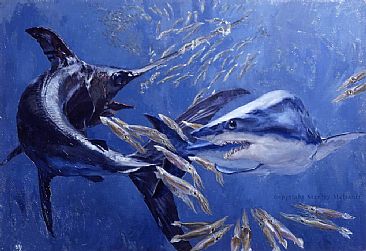But species don't exist in neat boxes. That's the fundamental truth behind ecology. When you go out to catch one species, you're bound to run across several other species as well, and even the most carefully designed fishing gear will occasionally catch something it wasn't supposed to.
A few months ago, I blogged about one of these problematic overlaps: butterfish and longfin squid. Here's another one: swordfish and shortfin squid.
Illex squid, commonly known as short finned squid, are among the favourite prey species of Atlantic swordfish. In the canyons offshore of the mid-Atlantic, swordfish are occasionally found in close association with schools of these squid. Consequently, some of these swordfish are inadvertently caught in the trawls of the commercial squid fleet.However, the management responses to the two situations are different. Because butterfish are not doing so well, the longfin squid fishery is required to stop fishing once it's caught too many butterfish--regardless of how many squid are still left.
Swordfish are in decent shape, though, so it's not as big a deal that the shortfin squid fishery kills them. The frustrating thing, though, is that the squid fishermen have to throw the swordfish overboard. They're not swordfish fishermen, so they're not allowed to catch and sell swordfish.
Pretty silly. So on August 10th, two years after a petition from the Garden State Seafood Association, the National Marine Fisheries Service decided to allow squid fishing vessels to hang on to 15 swordfish each.
Given that the swordfish are already dead, one way or another, this seems far superior to throwing them back in the sea.






Comments